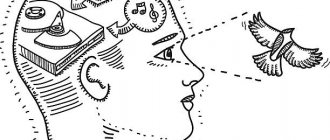All company employees, from the cleaner to the director, communicate with clients to one degree or another. And each of them forms an idea of the company. Personnel must know the basic rules and principles of communication with clients, follow ethics and master the basics of communication psychology. This is especially true in sales, where work is based on communication with clients. Of course, the quality of a product, product or service is very important, but some shortcomings can be smoothed out with the help of well-structured communication. A satisfied client will come back to you again or recommend you to his friends and acquaintances. Proper communication with customers is one of the factors for business success. In this material we will consider the main aspects of the process of communication with clients.
Psychology of communication with clients
Sales communication with clients is the main tool for attracting buyers. To properly structure the negotiation process, sellers need not only to be sociable, but also to master the basics of communication psychology.
The first impression is of great importance: further interaction directly depends on it. At the first meeting, a company employee forms an opinion not only about himself, but also creates an image of the company as a whole. Improper behavior can frighten the buyer and the company will lose profits. Therefore, you should approach each meeting responsibly and prepare.
The following tips will help you conduct successful negotiations:
- Before the meeting, clearly formulate your proposal. Try to anticipate the client's possible questions so you can be prepared to answer them.
- Evaluate your appearance: it should be neat and tidy, and if the company has a dress code, then comply with it.
- When you meet, look your interlocutor in the eyes, offer your hand first and greet weakly, then introduce yourself first.
- Do not violate a person’s personal space, keep a distance of about a meter.
Friendliness and respect for your comfort zone will put your interlocutor in a positive mood. After this, you can start a conversation.
Find out what a sales funnel is and why your business needs it
Test your knowledge
If you want to test your knowledge on the topic of this lesson, you can take a short test consisting of several questions. For each question, only 1 option can be correct. After you select one of the options, the system automatically moves on to the next question. The points you receive are affected by the correctness of your answers and the time spent on completion. Please note that the questions are different each time and the options are mixed.
Statistics Full screen
Kirill NogalesSergei Krutko
← Sales Management Theory Exam →
Ethics of communication with clients
A polite and respectful attitude during communication is always pleasant, so the ethics of business communication with a client becomes an important assistant in building a productive conversation.
Politeness is the main component of ethics. It must be demonstrated not only through words, but also through tone of voice, manners, and actions.
It is also extremely important to show respect to the interlocutor: monitor intonation, listen carefully, show interest, answer all questions. Under no circumstances should you interrupt, be distracted, put pressure on, or insist on making a decision right now.
The conversation should be relaxed, the information should be understandable. The interlocutor needs to be given time to think. The main thing is moderation in everything.
Psychological techniques for first contact
They are called marketing triggers. They involve the buyer in a conversation, help him open up, and help you strengthen the emotional connection with the client.
Smile
A friendly and sincere smile always comes in handy: a positive attitude is attractive and arouses sympathy. A manager who is in a good mood will sell more than a competitor with a tired or dissatisfied face.
"We are a statement"
Emphasize that you and the client are united by common goals: “We will decide with you,” “Our goal is...”. Such formulations help the buyer to feel involved in the affairs and values of the company - this inspires trust.
Intonation
It is intonation that places semantic emphasis in sentences, shows interest or detachment, and helps manage the emotions of the interlocutor. The main rules: speak confidently and clearly, pausing so that the client has time to think about what has been said. Important details can be voiced a little louder and slower.
Mirroring
A powerful tool for emotional influence. The essence of mirroring is the repetition of poses, facial expressions, and gestures. If you analyze the behavior of the interlocutor and adapt to his mood, pace and manner of speech, then he will feel comfortable, and a tense business conversation will become much more pleasant.
Rules and principles of communication with the client
There are basic rules that should be followed in communication, regardless of the company’s field of activity:
- Show an individual approach, focus on the client’s needs. The buyer should feel cared for, a desire to help, and not just sell.
- Speak to the client in a language that he understands so that the interlocutor does not doubt his competence. The ability to speak correctly with clients will save time on explaining terms, and thereby allow you to talk more about the benefits of the offer.
- Maintain a businesslike nature of communication: do not be late for meetings, answer calls and letters in a timely manner, take work issues and requests seriously.
- Maintain an impeccable appearance not only at the first meeting.
The principle “the customer is always right” is a very reasonable one, but you need to remember that there are exceptions to every rule. It is better to refuse manipulative clients, because they will not only waste your time and nerves, but can also damage your reputation.
Important nuances of communication by e-mail
- Seamless client pickup.
This is the ability to “intercept the client” so that he does not notice that someone else is working on his project. How can a manager communicate with such clients? Everything is quite simple: do not ask the customer again for details that you can glean from previous correspondence. If you are referring the client, then try not to miss out and send the entire previous history of your communication to the new manager.
- Do not change the subject of the letter.
This point is very important, since most business people correspond by filtering messages by subject. If you change even one letter or symbol in it, the letter will be lost.
If the topic of your conversation has changed dramatically, start a new topic for the letter and continue the discussion under a new thread.
- Clear subject line.
It is important to choose a topic for writing that even after a couple of years you could easily understand and recall your correspondence with the client.
If several people are involved in the correspondence, then you should send the answer to all participants in the conversation at once. The “replytoall” button in email clients will allow you to do this in one click.
- Summary and calltoaction.
At the end of any letter, be sure to summarize your conversation today and clarify what exactly you expect from the client in response. This is what will help you not to miss the client and not give him a chance to stray from the path you have planned.
Standards of communication with the client
Rudeness or improper behavior of staff can be costly for a business owner: it can affect profits or damage their reputation. To avoid this, many companies are developing and implementing customer communication standards that help employees avoid unpleasant situations and be as customer-oriented as possible. Standards are a set of rules and prohibitions that must be followed, as well as communication scripts. This is most relevant for sales managers, call centers, large companies, where it is impossible to control every employee, and the interaction of departments must be clear.
High-quality communication with clients is the basis of any company’s work and the key to high earnings for employees. It is necessary to maneuver between the interests of the client and the company. You need to speak the same language with the client, but not stoop to his level if the client swears or is rude. Just being a sociable person is not enough. These skills need to be learned and honed. The ethics and psychology of communication with the client will come to the rescue, which will allow you to create a good first impression and win over your interlocutor. By following the basic rules of communication with a client, you can build a productive business conversation and achieve your goals.
We talk about how to create a constant flow of customers into a business using social networks and the power of the Internet at an open online meeting.
Register here to receive a roadmap for the development of your project, which will clearly show how to achieve the result.
Ability to ask the right questions
The ability to ask the right questions is the last skill we would like to mention. It is very important and valuable, but you need to learn it constantly, each time striving for better results.
The right questions help clarify unclear points, relieve tension, avoid harsh confrontation, provide time to think about any issues, and better recognize the client’s position.
There are questions that are highly productive and provide a huge amount of additional information (open questions), but there are also less effective ones (closed questions).
With the help of open questions, the subject of discussion itself is revealed. They stimulate a person to tell a detailed and frank story. Closed ones indicate that the topic is no longer relevant and the dialogue can be stopped.
Despite the great effectiveness of open questions, you should not neglect closed ones - sometimes it’s easier to ask them in order to get more specific answers. To learn in detail about the intricacies of working with questions, we advise you to read our article “Techniques for asking questions.”
Now, to summarize the lesson, we can conclude that the manager and head of the sales department not only must be able to identify the essence of problems, quickly solve them and separate the main and the secondary, but must understand the intricacies of business etiquette, skillfully use psychological knowledge and skills and create a positive image of yourself. Taken together, this opens up the broadest professional horizons and allows you to achieve unprecedented success in your chosen field.
And at the end of the course, we invite you to take a little break and get acquainted with short descriptions of very interesting and useful books on sales, as well as watch entertaining and educational videos about sales. Surely you will find something for yourself that you will not fail to use in practice.
When do standards fail?
It is important to remember that it is not only the lack of service standards that can be the bottleneck of your service. If you, in principle, do not organize the work of field installers or the supply of missing spare parts, developing a service standard will not help create in the client the idea of quality service. When a client has to wait several days for a repair service to arrive, a smile on the field engineer’s face is unlikely to neutralize the negativity.
Before you start developing service standards, you need to make sure that your core business processes are working as they should.
A few more tips
Communicate as equals
Do not curry favor with the client, do not fawn - he should feel not like the king of the Universe, but your equal partner . You will have to learn this - especially if you are not a manager, but an ordinary employee. The client must respect you and value your opinion. To do this, you will have to prove yourself to be an excellent expert and show that you really understand the subject of the conversation.
Give compliments
Do you think these are mutually exclusive paragraphs? But no. We do not encourage you to use rude flattery - the standard phrases “You have good taste,” “You have an impressive portfolio on your website,” and so on are quite enough. The person will be pleased, and you will reduce the distance with the client and win him over.
Chat on unrelated topics
For example, about events in the world . Or the market situation in the area your client represents . Or about news from the same sphere - those that he knows for sure. Such conversations will quickly move you from the rank of a talking head to a full-fledged partner who understands the situation and is ready to give expert advice.
Mention an expert
A real expert in the field of sales or a person whom your interlocutor knows for sure. For example, the president. Or the head of a federal company. There is a risk, of course, that it is with this expert that your counterpart has a personal score - then a reference to him will be inappropriate and will only cause irritation. Correct the situation immediately by changing the tone and direction of the conversation.
Refer to a quote from a great man
Your interlocutor definitely has no personal accounts with Socrates, Newton or Pushkin. People love quotes - it brings them closer to the great and seems to give them a piece of wisdom. Stock up on such sayings for all occasions and use them in conversation. Don’t take too hackneyed quotes - it’s better to include something similar and not hackneyed. This will earn you the reputation of being a skilled communicator and earning the respect of your client.
And most importantly: remember that making contact for the first time is not everything. Customers need to be tamed and attracted so that they become permanent . One client for life is better than a dozen one-time ones. Good luck in business!
First conversation algorithm
In general, every large company writes scripts for this case . We also advise you to adopt this step-by-step algorithm and teach it to your managers. It doesn’t matter what form this dialogue will take - by phone, chat or in person.
Step 1. Tune in to the conversation
In a personal meeting, it’s simple: psychologically tune in to the conversation, smile, take an open pose (no crossed arms, no clamped limbs). This will subconsciously endear the client to you. A smile, by the way, works even during a telephone conversation. It has been verified that if you simply stretch your lips, even without feeling particularly positive, the brain reads this signal and begins to truly rejoice. And a person who smiles involuntarily conveys his mood to his interlocutor. And when two people are positive, the conversation will be easier and more friendly.
Step 2. Say hello and introduce yourself
The first phrase in a conversation is greeting. Many companies have greeting standards, for example: “Pearl Dentistry, Anna, I’m listening to you.” Such phrases fly out automatically from employees: we bet anything that administrator Anna answers personal calls in the same way on her legal day off.
In principle, this is the correct approach: the name of the company is spoken out so that the person is exactly sure where he ended up . A simple “Hello” or “Yes” forces a person to ask again: is this dentistry? Is this such and such a store? This wastes the time of both the caller and the company’s employees. The name of the employee must also be mentioned: for many clients it is easier to contact a specific Anna, rather than a faceless “girl”. This approach humanizes the employee and adds customer loyalty. Refusing a specific Anna and not making an order is also more difficult than sending the nameless employee at the other end of the line to hell.
The same thing works in the opposite direction. Ask what the client's name is, and henceforth call him that way. For example, if a client doesn’t give his middle name, you don’t have to ask, it means he’s used to it this way and not any other way. And vice versa: if you present yourself in full, meet his expectations.
Step 3. Ask a question
After introducing yourself, ask the key dialogue question. Don't be shy: after all, the person called or texted you first. So he needs something. The question is what? Find out this. The scripts can contain several answer options: “Are you looking for a specific product?”, “What did you want?”, “How did you find out about us?” and so on. Avoid neutral questions (“How can I help you?” - everyone has long been tired of this) and questions that can be answered with the word “no” (“Can I help you?”). The best questions are those that cannot be answered in monosyllables. For example, the question “How did you hear about us?” motivates the caller or writer to give a detailed answer. Let him speak - you can catch on to the thread and pull it further. Word for word - and the conversation will begin.
Step 4. Get the person interested
It’s like a sales funnel: at the first stages, a person doesn’t know what kind of company you have, then he begins to become interested and distinguish you from your competitors, then make a choice in your favor. You are in stage one. You need to tell him why he should choose you. Roughly speaking, what is your unique selling proposition? How are you better than others? What benefit can you bring to a person, what is his personal benefit?
Everyone has their own USP. You can offer really low prices, perfect service, free shipping, free estimates and measurements - you never know! also offer to send useful materials: articles, courses, instructions - all this in exchange for the client leaving contact information (this applies more to online dialogues). In the end, if you feel that the client is hooked and is about to place an order, offer him a discount - it should work!
If you work with b2b clients, or “business to business”, it is advisable to quickly dig up at least minimal information about the client. Yes, just like this: at the same time you communicate and enter the name of the client’s company into the search engine . A minimum of actions will give you maximum information: you will impress the client with knowledge about the specifics of his company. It's flattering, it's nice. This will give you a significant advantage compared to other competitors.
Step 5. Listen to the person
Your monologue about the best company in the world or the best product in the world is of no interest to anyone. People love to talk about themselves. Let the client speak: if he is ready to tell, listen carefully, if not, ask leading questions, push for answers. In particularly difficult cases, use the rule of three yeses: if a person has already answered yes to two of your questions, there is a high probability that he will answer yes to the third. And the third, as you may have guessed, will be a direct selling question. Whoosh - the deal is completed, and the client is in the bag.
Step 6. Offer a ready-made solution
And only now you have brought the client to the final stage of the sales funnel. Now he knows who you are, how you can be useful to him, and is ready to make a decision to purchase a product or service. Press him - tell him about profitable discounts and promotions, polish the impression with a story about well-known companies that use your services, tell him more about the advantages. And, of course, offer a ready-made solution that is most suitable for the client . That's it, he's yours.
Contact between subordinate and supervisor
One of the main rules that business communication etiquette prescribes is respect for the manager by subordinates. This does not mean that he needs to be flattered or agree with everything.
An employee with his own views and opinions on issues related to work issues, and who knows how to present this in the correct form, is a good employee. Such subordinates are devoted to their company and do not neglect speech etiquette in business communication.
When talking with your boss, it is not recommended to point out the detected shortcomings in a harsh manner. The culture of business communication in such contact comes down to the ability of a subordinate to convey the necessary information to the manager without flattery, lies or cunning. In a calm and friendly atmosphere in a team, this is not difficult to do. Relationships between subordinates and managers, built on trust, are the application of ethical rules in business communication.
If a subordinate wants to make suggestions to improve the company's performance, then he should not immediately go to the top manager of the company. First you need to contact your nearest boss, otherwise the chain of command will be broken. In the future, such behavior of a subordinate will cause discord in the team.
Behavior reminder
The basic principles of effective interpersonal interaction are:
- mutual assistance;
- respecting someone else's space;
- respect;
- cultural communication.
When in any public place, you should adhere to the culture of behavior that is acceptable for that place:
- When on public transport, it is not recommended to push others around in order to find a free seat or get out as quickly as possible. You should give up your seats to the elderly, children, and women. Large bags should be placed in a place where they will not interfere. The backpack should be held in your hands.
- While in various stores and large supermarkets, it is not recommended to take unnecessary goods from the shelves and then leave them in places not intended for this.
- While at work, you must adhere to the rules that are established in this institution. This could be a certain type of clothing, hairstyle, jewelry. It is not recommended to discuss personal topics with colleagues. Also, you should not discuss your colleagues themselves, especially behind their backs.
- When attending a movie screening, it is not recommended to talk loudly, comment on what is happening, rattle cans or rustle bags. All this bothers others and causes irritation. Any remaining trash must be thrown away at the end of the session.
- While in a medical facility, it is not recommended to talk loudly or use mobile phones, especially if diagnostic equipment is located nearby. If there is a queue, you will have to stick to it.
By following the rules of good manners, a positive impression is created and a positive attitude is formed among others.
For more information on etiquette rules when communicating with different people, watch the following video.
How to resist arrogance and rudeness
Unfortunately, the culture of our society is not as high as we would like. Working in the service sector, you will often encounter arrogance, rudeness, inappropriate behavior, and sometimes aggression. First you need to learn to take this for granted and stop being surprised by this behavior. This will give you the opportunity to learn to demonstrate to your interlocutor that you are not affected by his behavior. The roots of rudeness and arrogance go back to a person’s childhood and upbringing; it is impossible to change his behavior pattern. The most correct behavior would be to demonstrate that this behavior does not work with you and that the person himself will reorganize the dialogue with you in a constructive manner. How to do it? There are several options that can be used depending on the situation.
- If you are approached in a rude manner, you may not notice or ignore the request. In general, a policy of completely ignoring inappropriate behavior can often help;
- You can quickly ask a rhetorical question. The goal is to unsettle the manipulator, make him think and thereby seize the initiative;
- Laugh it off. Often a boor does not expect you to laugh, he expects your resentment and anger. Hearing laughter, he is lost;
- Astonishment. You can show your disappointment in the person as an interlocutor. Try to shame him by saying a general phrase like “yes, I see the language of Chekhov and Dostoevsky died a long time ago.” I’ll say right away that this tactic will only work if you are being rude not out of malice (this also happens), this trick will not work with boors, manipulators and insolent people.
Recommended reading:
| Book “How to Talk to Anyone, Anytime, Anywhere” by Larry King - buy the book How to Talk to Anyone, Anytime, Anywhere on OZON.ru with fast delivery by mail | 978-5-9614-6097-1 |
| The book “Psychology of Persuasion. 50 Proven Ways to Be Persuasive" Noah Goldstein, Steve Martin, Robert Cialdini - buy the book Yes!: 50 Scientifically Proven ways to be Persuasive on OZON.ru with fast delivery by mail | 978-5-00057-972-5 |
| The book “Tricks of Language. Changing Beliefs Using NLP" Robert Dilts - buy the book Sleight of Mouth: The Magic of Conversational Belief Change on OZON.ru with fast delivery by mail | 978-5-496-00625-5 |
Development and implementation of service standards
There is no generally accepted approach or methodology for developing customer service standards, nor is there a specific role in the company that should do it. As a rule, standards are developed by marketing, sales or management departments.
When developing and adjusting customer service standards, it is necessary to respect the interests of several parties simultaneously:
- companies - service standards must primarily ensure profit;
- clients - the service and all related services must meet his expectations;
- employees - they will have to comply with the developed standards every day.
It’s worth starting the development by identifying customers’ ideas about quality service. You can talk to employees, conduct surveys or individual interviews with clients, and compare yourself with competitors. It would be good if at this stage service bottlenecks are identified and eliminated.
When developing a standard, it is worth going through the entire process of working with the client in his “skin” - signing or renewing the contract, receiving an appeal by phone or other communication channel, working on the appeal and closing the application. Each step must be described formally, highlighting the important features of the service. And you shouldn’t rely on the experience of your best employees for everything. Despite their high performance, they may well make mistakes. It's better to focus on what the ideal service for your customers should look like.
General rules for all stages of service or a detailed description of each of them are formulated in the form of an internal document and approved by the manager. But before it becomes the main reference for customer service, it is worth allocating time and resources for its implementation - training staff in new work methods, reinforcing behavior patterns.
And remember, customer service standards can and should evolve with the company.
Metrics to monitor performance
There are several metrics by which you can judge the effectiveness of implemented customer service standards.
- LTV - Lifetime Value - the total profit that a client brings while working with the company. The metric shows customer loyalty and the benefits of interacting with each of them. This is a financial indicator that can be calculated without the participation of the client himself.
- CSAT - Customer Satisfaction Score - a satisfaction index, in fact, its assessment of the work of a specific operator or service department based on an application. This is a direct assessment of the client, which is worth obtaining from him after the closure of the next request.
- CES - Customer Effort Score - effort index. This is another assessment from the client, which asks him to estimate the amount of effort on his part that was required to resolve the issue. Like the previous one, the metric relates to a specific request and evaluates the work of the service department at a given time.
- NPS - Net Promoter Score - customer loyalty index - his own assessment of how likely he is to recommend the service to colleagues. This metric shows the level of service as a whole, and not the work of a specific specialist. At the same time, it may be influenced by previous negative or positive experience of interaction with the company.
These metrics do not have an objectively “bad” or “good” level. They need to be monitored over time in order to notice the deterioration of service in time and see the results of innovations. This can be done using dashboards from help desk systems, such as Okdesk.
How to communicate on the phone correctly?
When communicating on the phone, there is no eye contact, so the main and decisive impression is formed on the basis of the greeting. The first phrases spoken, intonation, and manner of communication affect the result and the duration of the entire conversation.
Telephone communication begins from the moment the phone starts ringing. According to the rules of good manners, the phone should be picked up immediately after the third ring. It is recommended to wait until the eighth ring for a response.
After the answer is given, it is important to say hello as politely as possible and be sure to introduce yourself
It is important to maintain a measured pace of speech here. Speech that is too fast is difficult to hear and its meaning is often missed
A slow pace can start to irritate the other person and they will become distracted. The voice should not be too quiet and not too loud.
To maintain a positive attitude when talking, you need to smile. A smile is always felt when talking on the phone, and it gives a special politeness to the voice. It is recommended to periodically contact you by your first name or patronymic name. A person is always pleased to hear his name. In addition, it adds a touch of individuality.
However, the interlocutor should not guess that the words have been prepared in advance. The conversation should take place in the most natural, relaxed manner possible.
It is important to pause between meaningful sentences, giving the person the opportunity to express their opinion on the issue under discussion. You need to listen carefully and actively
This can be done using short phrases such as “yes”, “okay”, “I see”.
It is necessary to end the telephone conversation on a positive note. You cannot abruptly break off communication. The last phrases are very important. A proper farewell is almost the last chance that can help change the situation in the opposite direction. Therefore, it is better to plan it in advance.
Business ethics. What you need to know about business collaboration culture?
The ethics of business and professional relations is an old concept that arose from the time people carried out the first transactions of exchanging any objects. It is obvious that today business ethics has changed significantly and includes respect for the rights of every person, the adoption of universal standards of behavior, and strict implementation of laws and regulations.
Ethical rules for business relationships
The rules of business etiquette or professional ethics are built primarily on compliance with generally accepted moral norms and legal norms. Not all means are suitable for achieving goals and obtaining greater profits. Competition, no matter how tough it may be, should not be conducted using “dirty” methods.
Main areas of business ethics
Each direction has its own principles, both enshrined in law and unwritten rules accepted by society as necessary.
Relationships within the team
Internal ethics are determined by each company independently, taking into account industry or historical traditions. Along with this, there are uniform standards:
- protection of the rights of all workers, regardless of qualifications and position;
- inadmissibility of inequality of workers' rights;
- availability of information about the company’s activities to each employee within the limits of his authority;
- interaction between the manager and subordinates should be based on authority, and not on power decisions.
Partnerships
The rules of partnership relations indicate the inadmissibility of any fraud or fraud. Fraud is a form of deception that produces short-term results. Information about fraud during a transaction will sooner or later be revealed and will lead to further financial losses.
Customer Relations
Today's client has sufficient information, so misleading him is not only difficult, but also fraught with consequences, given possible legal proceedings.
Communicating with the client:
- be polite, but do not ingratiate yourself;
- do not allow excessive pressure, communication should be from a position of equality;
- fulfill your obligations in full and on time;
- do not allow business communication to develop into a banal conflict;
- Watch your behavior, speech, appearance.
Extrasocial standards
Non-social standards include environmental and aesthetic rules for doing business. For example, dumping waste into a river is a process that has a negative impact on the environment and is contrary to all ethical standards.
Strict adherence to business ethics will allow you to: create a businesslike, working atmosphere within the team; organize mutually beneficial cooperation with partners; gain a decent reputation among clients. All this will contribute to the development and prosperity of business.
Examples of dialogues with customers
Socratic dialogue
The consultant builds the dialogue in such a way that he first pronounces several sentences, to which the client answers in the affirmative without any doubt. And then comes the selling phrase, to which the client also says “Yes.”
– Look at the style of this skirt - an unusual design decision, isn’t it?
- Yes, I agree!
– The composition is 100% silk, touch it, do you feel how soft it is?
- Yes, very nice fabric.
– This model is universal, it will look great with both a blouse and a turtleneck, don’t you agree?
- Yes.
- Let's try it on?
- Yes, let's do it!
Experts say that three phrases are enough. But in reality, sometimes the situation is much more complicated. If you ask too simple and monosyllabic questions, the client will quickly figure you out. Therefore, be as natural as possible and show genuine interest in the potential buyer.
Long phrases
You may notice that a beginner will speak in short, monosyllabic phrases, while a consultant with more experience will speak in longer ones. With him, each sentence seems to follow from one another, connected by the conjunction “and”.
“Train” phrases, as they are often called, lull the buyer’s vigilance and set him up for more confidential communication with the consultant.
Finger on the pulse
If during a dialogue a potential buyer begins to wander off the topic of conversation, the consultant can bring the conversation back on track by asking him: “What do you think...?” or “Which characteristics will be most useful to you in life?” In this way, he will return the conversation to the right direction and understand whether the person understood the previous information about the product.
Let's find out the past
It may well turn out that the buyer, based on his previous bad experience, does not trust the quality of such a product. Your task is to show him that you should not limit yourself in the present because of negative experiences in the past. You just need to be more careful when choosing.
– Not long ago I bought a dress in a bright color. After a couple of washes, it looked like it had been worn for at least ten years...
– I understand you very much. There are unscrupulous clothing manufacturers. But you must admit, this is not a reason to deny yourself bright things now.
- Agree.
– You just need to pay more attention to the composition of the fabric and the dyes used. Buy only from trusted brands.
20 types of clients: strategy for working with each
Learning to recognize your clients
More details
Wisdom of the ancestors
Catchphrases sometimes help in dealing with client objections. It is unlikely that anyone will argue with what has been proven by a hundred years of experience.
– I just fell in love with these ankle boots, but it seems to me that they are too overpriced!
– Here I agree with you that the price is really not the lowest, but, you know, a designer model cannot be cheap. And besides, we are not rich enough to buy cheap things, are we?
Features of conflict-free communication
During a conflict, there is a clash of opinions, interests, and positions. The result of confrontation can be the achievement of a common goal or destructive consequences. Therefore, it is necessary to strive to transform any conflict into a positive direction, and, if possible, prevent it altogether.
It is imperative to give your opponent the opportunity to get out of the situation with dignity. In order not to create preconditions for confrontation, it is recommended to adhere to simple principles that allow you to effectively interact with others.
These include:
politeness; respect; positivity; openness; attention; decency; concreteness; maintaining personal boundaries; tolerance; justice; compassion.
The ability to put yourself in the position of another person allows you to understand the motives of his behavior and look at the situation from a different angle. You should not react to aggression emotionally. This could lead to an uncontrollable dangerous situation. Also, do not give in to provocations.
Conducting correspondence
12.1 Letters from Employees should be addressed only to those who, due to their official duties, are interested in receiving them.
12.2 The text of the message must contain only the necessary information. The sender must express his thoughts briefly and clearly in order to avoid double interpretation.
12.4 When sending messages, the sender’s first and last name and contact telephone number must be indicated
12.5 Company employees are required to regularly analyze the contents of their personal mailbox.
12.6 If the Employee has received a letter from the Client to which it is necessary to respond, this must be done no later than three days
from the moment of receiving the letter.
12.7 Before going on vacation or a long business trip, an employee of a department working with Clients, Partners of the Company or other interested parties is obliged to notify Clients, Partners of temporary absence and provide the email address of a replacement person.
Communication goals
In any communication, a person consciously pursues three goals:
- cognitive – dissemination or acquisition of new knowledge, skills, material things;
- incentive – stimulating other people to take certain actions;
- expressive – expressing or experiencing emotions.
These goals can be achieved if you have:
- knowledge and skills - a person knows something, can do it and can share it with others;
- incentives that encourage action;
- emotions.
Agree, you can sell a product only by thoroughly knowing everything about it and being able to share this knowledge so that a person has a desire to purchase it and at the same time experiences positive emotions.
Paperwork
11.1 All outgoing advertising and informational documents intended for consulted Clients must be printed on blank paper.
11.2 An employee of the Company must ensure the accurate execution of documents.
11.3 It is unacceptable to use sheets torn from a notebook.
11.4 Particularly important documents of the Client must be neatly placed in a file.
11.5 At the end of work or in cases of temporary absence from the workplace, it is prohibited to leave work materials (credit dossier, certificates, notices, notices, etc.) on the tables in the public domain.









